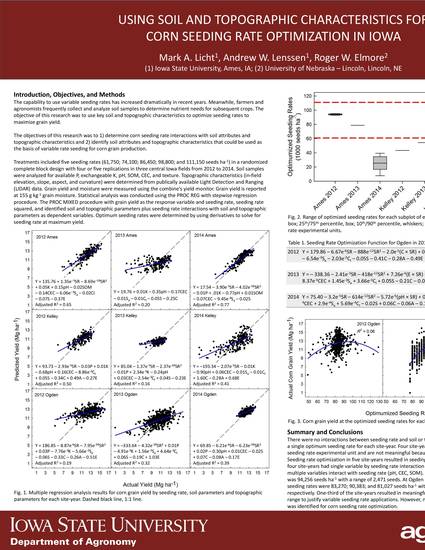
The capability to use variable seeding rates has increased dramatically in recent years. Meanwhile, farmers and agronomists frequently collect and analyze soil samples to determine nutrient needs for subsequent crops. The objective of this research was to use key soil and topographic parameters to optimize seeding rates to maximize grain yield. Treatments included five seeding rates (61,750; 74,100; 86,450; 98,800; and 111,150 seeds ha-1) in a randomized complete block design with four or five replications in three central Iowa fields from 2012 to 2014. Soil samples were analyzed for P, K, pH, SOM, CEC, and texture. Topographic characteristics (elevation, slope, aspect, and curvature) were determined from publically available Light Detection and Ranging (LIDAR) data. There were no interactions between seeding rate and soil and topographic variables in four site-years. Three of these site-years had a negative and linear seeding rate response with an optimal seeding rate below 61,750 seeds ha-1. Seeding rate optimization in five site-years resulted in seeding rate by soil and topographic variable interactions with four site-years having an interaction with a single variable (pH, elevation, curvature) and one site-year having an interaction with three variables (pH, CEC, SOM). The mean optimized seeding rate at Ames in 2012 was 94,256 seeds ha-1 with a range of 2,471 seeds. At Ogden in 2012, 2013, and 2014 the mean optimized seeding rates were 83,270; 90,383; and 81,027 seeds ha-1 with a range of 22,408; 23,723; and 13,495 seeds respectively. Overall, 33% of the site-years resulted in successful seeding rate optimizations with a wide enough range to justify variable seeding rate applications. Even in those three site-years, no single soil parameter or topographic characteristic was identified for corn seeding rate optimization.
Available at: http://works.bepress.com/mark-licht/159/

This is an abstract of a presentation from the ASA-CSSA-SSSA Annual Meeting, Minneapolis, MN, November 15-18, 2016. Posted with permission.